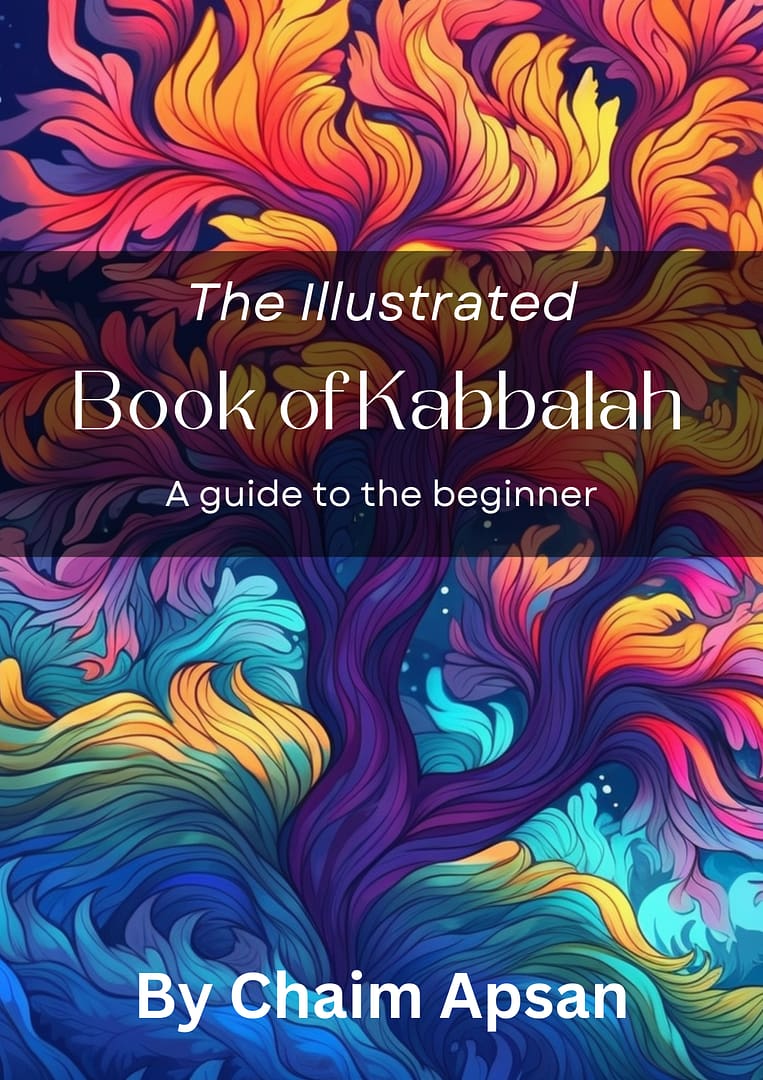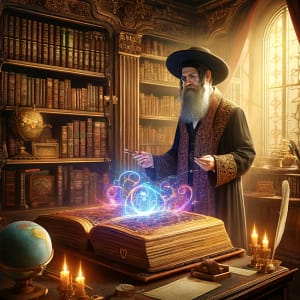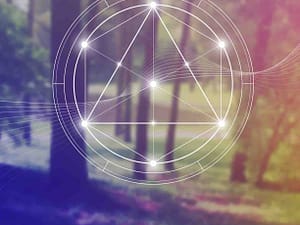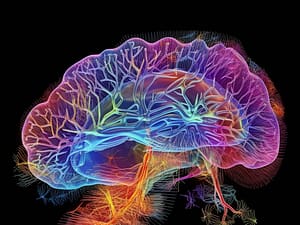Many people just skip the Tefilat Ana Bekoach, but within these short 7 lines we find awesome insights from Kabbalah.
This short prayer was written by Rabbi Nehunia Ben HaKanah, one of the greatest Tannaim of the first century C.E who was so holy he would burn birds while performing yichudim (some say “birds” is a metaphor for angels).
The prayer Ana Bekoach looks relatively simple. Its seven stanzas, each consisting of six words, are meticulously crafted. If you take the first letter of each of the words, you form 7 divine names that must not be pronounced.
(As a general rule, we only say the holy names of God when they are in pesukim or prayers, otherwise we just meditate on them).
According to the Minhag of the Arizal and Rashash (Rabbi Shalom Sharabi), this prayer is said on Shacharit, Mincha, before going to sleep and on Sephirat HaOmer. The Ashkenazim also recite it on Kabalat Shabat and Mincha of Shabat, but that’s not the minhag of the mekubalim.
Each of the stanzas are related to a specific day of the week in which additional Kavanot are intended.
I bring the prayer Ana Bekoach below (taken from Wikipedia). It’s pretty interesting they included the Sephirot related to the day in the table:
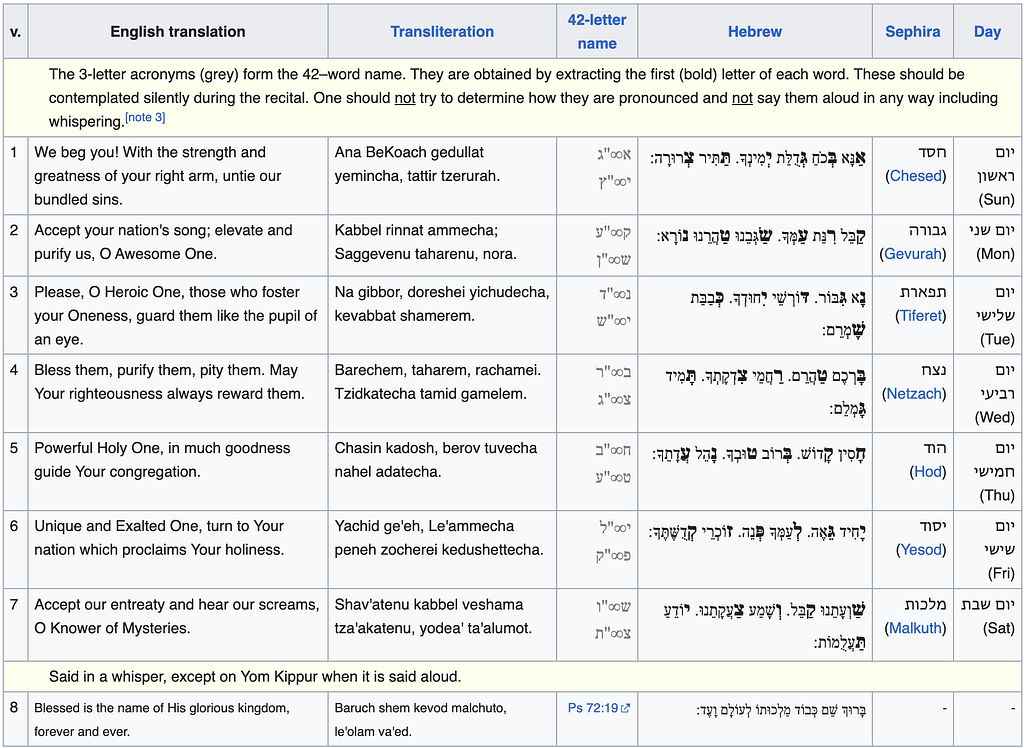
Lifting the spiritual worlds with the Ana Bekoach Kabbalistic prayer
We all consider it a simple concept that we lift things with our hands. Well, Hashem also has “hands” and here would probably be the best moment to digress and explain one of the most piercing conundrums in Jewish thought and Kabbalah.
The Torah is filled with anthropomorphic language. In the Tanach, we find the words “hands”, “head”, “legs”, “eyes”, “ears” and so on, being freely used to describe Hashem. This would seem to fly in the face of the rabbinic injunction against Hagshama (attributing physicality to Him).
If you’d say these are all mere metaphors, then why not use something for which we wouldn’t fall into the trap of physicality, like making a new word for it? And besides, if the Torah is the source of all truth, then it must be truth on all four levels, Pshat (simple), Remez (allusions), Drash (expositions) and Sod (secret).
So how do we explain that?
The first thing to understand is that we are all in the lowest of the spiritual realms, called Assiyah. Actually, our physical bodies inhabit the even lower physical part of the world of Assiyah. Our physical bodies are, in fact, furthest away from the truth of the higher realms, and therefore barely resemble anything there.
So, of course, there’s no physicality in the spiritual realms, but it’s not like the Torah is a metaphor for Hashem and we have “real” hands. Rather we, humans who are created in the divine image are metaphors for the Torah. Meaning, we don’t have real hands, but only a gross imitation of what real hands are. It’s only when we are elevated to the higher realms that we can perceive what real limbs are, and they don’t look anything like we have.
What we can understand from it is that the figurative language used in the Torah:
- Denotes the actions that Hashem performs in the world as in “smells”, “hears”, “sees”, etc…
- Expresses the level of that light (i.e. the eyes are higher than the nose, which is higher than the mouth).
Therefore, just as we use our legs to go to places, so too Hashem “goes” to places (like war) using His “legs” (which are the Sephirot of Netzach and Hod). Just as we use our eyes to see, so too, Hashem uses his “eyes” to “see”. One example is said when He “went down” to “see” the iniquity of the generation of the flood.
Just as we use our hands to lift things up, so too he uses his hands to lift up the spiritual realms of Beriyah, Yetzirah and Assiyah.
In the Tefila of Shacharit, there’s extra effort required to perform the Tikkunim because we just woke up the Partzufim of Zeir Anpin and Nukva need to be rebuilt. Not only that, but the spiritual realms also need to be lifted up from the lowest point and the lower worlds also need to be included in the higher ones.
The way to do this is by using Hashem’s “hands” which are actually 3, as mentioned throughout the Tanach:
- Yad HaGedolah – The great hand, right side, Chesed
- Yad HaChazakah – The strong hand, left side, Gevurah
- Yad HaRamah – The raised (or lifting) hand, center, Tiferet

Therefore, since all the spiritual realms are separate and down, we must unite them in the Shacharit prayer (as opposed to Mincha and Arvit). There are 2 types of elevation:
- The spiritual worlds of Beriayh, Yetzirah and Assiyah of Atzilut. This is accomplished in specific points of the Shacharit and the Kaddish. As many people might know:
- From Korbanot until the end of Hodu and the Menorah Psalm 67, we are lifting the spiritual world of Assiyah to Yetzirah.
- From Baruch Sh’amar to Yishtabach, we are lifting Yetzirah to Beriyah.
- From the Brachot of Shemah Yisrael until “Adonai Sefatai Tiftach”, we are lifting Yetzirah to Beriyah.
- Finally, in the Amidah we are bringing them all together to Atzilut for the Yichud on Sim Shalom.
- The lower spiritual worlds of Beriyah, Yetzirah and Assiyah. This is accomplished with the rest of the prayer. But most notably, the heavier job is to lift Assiyah to Yetzirah since it is closes to the domain of the Sitra Achra.
For item #1, it’s relatively straightforward.
For item #2, the job of bringing Assiyah to Yetzirah is carried out in 3 different points:
- In the last verse of the Tamid: “V’et HaKeves HaSheni…”, when you say “Yishe Reiach Nikhoakh L’Hashem”, you are doing the first lift.
- On the Ana Bekoach prayer we are doing the second lift (see picture below, at the very bottom).
- On the 7 Mishnayot of Eizehu Mekoman (Zevachim 5), we are doing the third lift while at the same time passing the Berurim of Assiyah through the 7 Heikhalot of Z”A of Assiyah.
The Kavanot of Ana Bekoach
As mentioned before, the first Kavanah of Ana Bekoach is lifting the spiritual realm of Assiyah:
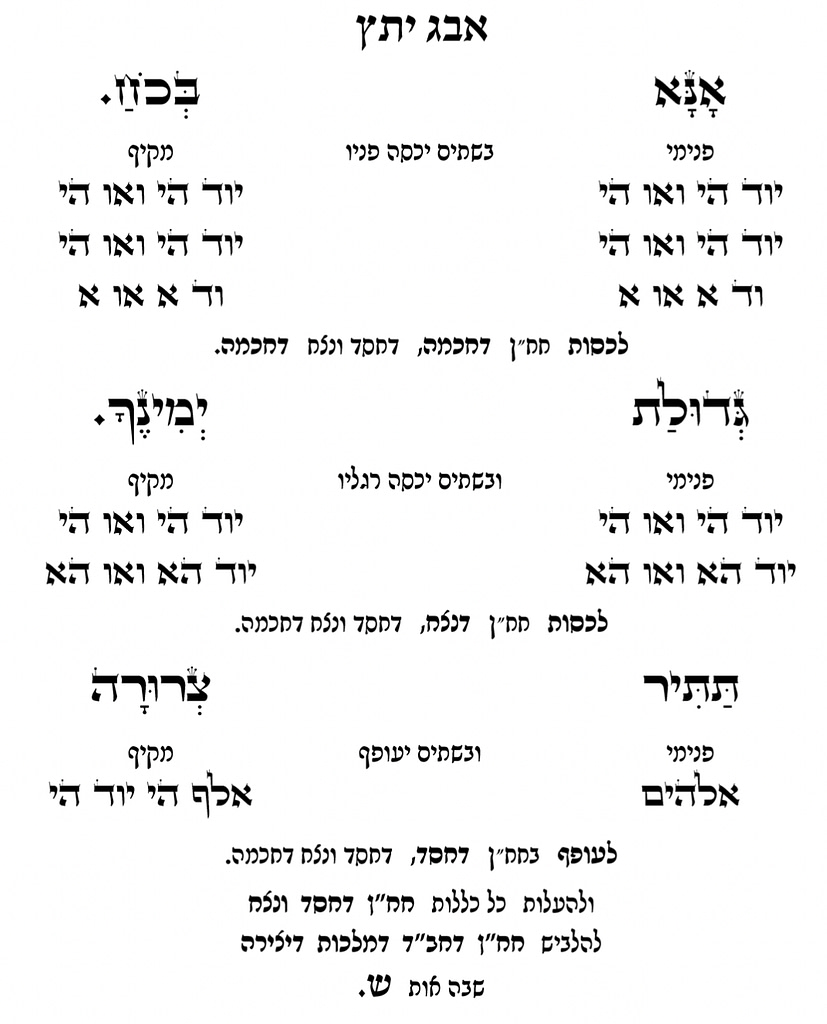
Some other insights
As one can see from the image above, each of the verses of Ana Bekoach we are supposed to be Mekaven one of the letters of the last name שק״ו צי״ת. The first verse we should think on Shin, the second on Kuf, the third on Vav and so on.
The Ana Bekoach prayer is used also in the Sephirat HaOmer count. During each day, the Arizal teaches us (through Rabbi Chaim Vital) that we should focus on the corresponding word of the Ana Bekoach prayer. This Kabbalistic prayer has 42 words + 1 for the generality of each of the 7 verses = 49 days of the Omer. Each day is a completely different Tikkun in which we are bringing down completely new lights that will culminate on Shavuot.
It’s also a custom to use it during the bedtime Shema prayer before going to sleep. The reason is that, as a person sleeps he also effects Yichudim in the spiritual worlds above and we want to also rise together with them to be properly revitalized.
Interestingly enough, while we know why the Ana Bekoach prayer is used in Shacharit, the Arizal and Rashash didn’t reveal to us why we say it during Mincha and so most Kabbalah siddurim I’ve seen recite it without Kavanot. As mentioned before, we are not effecting a proper aliyah during Mincha (as far as I know), so it’s a wonder why we have the prayer there.
Either way, this is a very small summary of what is actually happening during prayer. It’s meant to show the great importance of doing the entire Seder of Shacharit as it is, without skipping. The reader is encouraged to study these Kavanot in-depth to understand them better.

